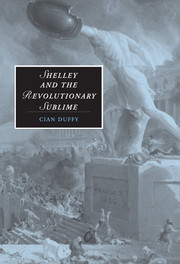Book contents
- Frontmatter
- Contents
- Acknowledgements
- Note on texts
- List of abbreviations
- Introduction: Approaching the ‘Shelleyan sublime’
- 1 From religion to revolution, 1810–1813
- 2 Cultivating the imagination, 1813–1815
- 3 Mont Blanc and the Alps, 1816
- 4 Writing the revolution: Laon and Cythna (1817)
- 5 ‘Choose reform or civil war’, 1818–1819
- Conclusion: ‘Good and the means of good’, 1822
- Notes
- Bibliography
- Index
- CAMBRIDGE STUDIES IN ROMANTICISM
5 - ‘Choose reform or civil war’, 1818–1819
Published online by Cambridge University Press: 15 December 2009
- Frontmatter
- Contents
- Acknowledgements
- Note on texts
- List of abbreviations
- Introduction: Approaching the ‘Shelleyan sublime’
- 1 From religion to revolution, 1810–1813
- 2 Cultivating the imagination, 1813–1815
- 3 Mont Blanc and the Alps, 1816
- 4 Writing the revolution: Laon and Cythna (1817)
- 5 ‘Choose reform or civil war’, 1818–1819
- Conclusion: ‘Good and the means of good’, 1822
- Notes
- Bibliography
- Index
- CAMBRIDGE STUDIES IN ROMANTICISM
Summary
On 6 November 1817, Princess Charlotte – ‘the much-loved only daughter of the much-hated Prince Regent’ – died in childbirth. Public mourning was immediately declared. Two days later, the leaders of the Pentridge uprising were publicly executed at Derby. Shelley responded to these events with his Address to the People on the Death of Princess Charlotte, written on 11 and 12 November. Although ostensibly concerned with Charlotte's death – which dealt, in itself, a significant blow to Radical hopes – Shelley's Address is actually a stinging critique of Britain's political institutions. ‘A beautiful Princess is dead’, Shelley affirms, ‘liberty is dead’: ‘let us follow the corpse of British Liberty slowly and reverentially to its tomb’ (PW, p. 239). Faced with this ‘death’, the Address identifies the political ‘alternatives’ available to the British people as ‘a despotism, a revolution, or reform’ (PW, p. 237). Just under three years later, and in the wake of the Peterloo Massacre, Shelley's Oedipus Tyrannus (1820) advised the government to ‘choose reform or civil war’ (CPW, p. 389). Continued ‘despotism’ was no longer an option: Britain, Shelley felt, was on the verge of a violent revolution that could only be avoided if the government allowed the reform of parliament.
Throughout these turbulent years, Shelley's own work – his ‘great revolutionary poetry’ – was explicitly concerned to forward the moral and intellectual revolution that he, following Godwin, believed to be the pre-requisite of any ‘prosperous’ change in ‘political institutions’ (Poems, ii, pp. 36, 35).
- Type
- Chapter
- Information
- Shelley and the Revolutionary Sublime , pp. 149 - 186Publisher: Cambridge University PressPrint publication year: 2005

